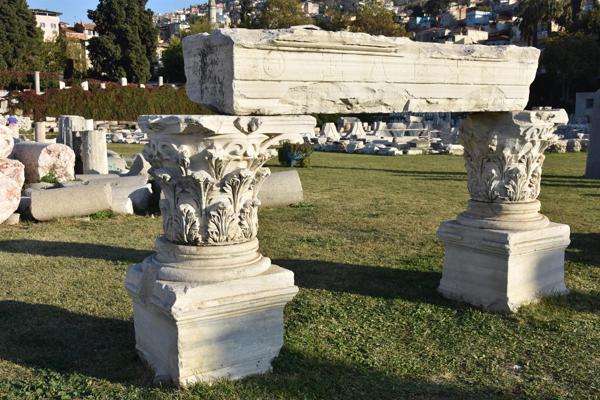Smyrna Agora documents reveal clues about İzmir quakes
İZMİR


The finds in Smyrna Agora, known as the largest ancient-period agora in a city center, have revealed information about the previous earthquakes in İzmir.
Stating that there are many clues about the earthquake in the ancient city, Associate Professor Akın Ersoy said: “There are inscriptions and documents of the İzmir earthquakes that occurred in the middle of the sixth century and in 177 in the city.”
Founded by Alexander the Great on an area of 193 hectares, the 8,500-year-old ancient city covers an area from Kadifekale to Kemeraltı.
In the ancient city, which offers many clues about the daily life of ancient times, 1,483 objects were found during the excavations that have been ongoing for the last 14 years. Along with these objects, it was revealed that the agora has many pieces of evidence about the earthquakes that occurred in İzmir throughout history.
Ersoy, a lecturer at the İzmir Katip Çelebi University’s Department of Turkish-Islamic Archaeology and the head of the ancient city of Smyrna and Agora Theater excavation team, pointed out that there were important inscriptions, artifacts and documents regarding the earthquake in Smyrna.
Stating that the earthquake that occurred in İzmir on Oct. 30 last year had similar ones in the past, he said: “At this time last year, a big earthquake occurred in İzmir. I am one of the victims of this earthquake. There are important inscriptions in the ancient city of Smyrna emphasizing the seismicity of İzmir. There is a work, in which the governor of the period is honored to make İzmir a city again after the earthquake. We believe that there is probably a bronze statue of the governor on this work. There is a concrete inscription and documents from ancient sources. In these documents, they describe the seismicity in İzmir. Many clues provide us with 2,500-year-old records of İzmir’s seismicity.”
Mentioning an inscription found in the ruins, Ersoy said: “There is an inscription dating back to 551 B.C. An inscription was found, showing that the governor of İzmir at the time reestablished the city after the earthquake. We reached this inscription in 2009 and made it visible. This is the document of an earthquake that occurred in İzmir in the middle of the sixth century. According to ancient sources, İzmir had an earthquake in 177-178. We learn about this earthquake from the surviving works of an oratory artist named ‘Aristides.’ We learn from him that the sun of İzmir faded at that time. Aristides asked for help for İzmir. On the other hand, the square masses were built to prevent the collapse of the structures against the earthquake.”
Thousands of objects found in 14 years
Drawing attention to the habitable feature of İzmir, Ersoy said: “The characteristic of this city is that it is a livable city just like Istanbul. There are two large areas in this region that are first-degree archaeological sites. The first is Kadifekale. Just below it is Smyrna Theater and Smyrna Agora. In ancient times, this was a spot that every resident of İzmir visited at least once a day. This area was a place where there were stalls, religious rituals and all kinds of activities were held in daily life. We have received the support of our sponsors in our 14 years of work. We delivered 1,483 objects to the İzmir Museum, where we have a corner of the sculptures we unearthed during the Smyrna excavations in the last 14 years.”
Speaking about the water inside the Smyrna Agora, Ersoy said: “There are canals on the slopes that collect the waters of İzmir and transmit it around the city. There are a lot of graffiti describing the daily life of the ancient ages. We have not been able to open this part to visitors until now, but we are planning to open it soon. It is not possible to estimate how long the excavation works will continue. The structure that people of İzmir are most curious about is the Smyrna Theater. We aim to reveal this structure as soon as possible. We unearth finds that we never expect. For example, a toilet structure was found in the theater. It takes time to clean and document such unexpected works. All these things prolong the duration of archaeological excavations. Efforts also continue for the agora to be included in the UNESCO list. At the center of these works are the Agora of Smyrna and the Historical Kemeraltı Bazaar.”
